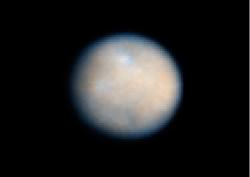The next few years will be banner ones for learning about dwarf planets. While the high-profile New Horizons spacecraft zooms towards a Pluto date in 2015, the Dawn spacecraft is making a more stealthy (in terms of media coverage) run at Ceres, which is the smallest and closest dwarf planet to Earth.
The Dawn spacecraft, as readers likely recall, made its first port of call at fellow protoplanet Vesta. What excites scientists this time around is the likelihood of water ice on Ceres’ surface. Vesta, by contrast, was very dry.
Here’s Dawn’s agenda once it gets to Ceres in April 2015:
“Dawn will make its first full characterization of Ceres later in April, at an altitude of about 8,400 miles (13,500 kilometers) above the icy surface. Then, it will spiral down to an altitude of about 2,750 miles (4,430 kilometers), and obtain more science data in its survey science orbit. This phase will last for 22 days, and is designed to obtain a global view of Ceres with Dawn’s framing camera, and global maps with the visible and infrared mapping spectrometer (VIR),” NASA stated.
“Dawn will then continue to spiral its way down to an altitude of about 920 miles (1,480 kilometers), and in August 2015 will begin a two-month phase known as the high-altitude mapping orbit. During this phase, the spacecraft will continue to acquire near-global maps with the VIR and framing camera at higher resolution than in the survey phase. The spacecraft will also image in ‘stereo’ to resolve the surface in 3-D.”
Dawn will then zoom down to an altitude of just 233 miles (375 kilometers) in November 2015 for three months to obtain information about elements and the dwarf planet’s gravity. Dawn will use its Gamma Ray and Neutron Detector (GRaND) to do the first part and a gravity experiment to perform the second.

To conserve fuel, Dawn will also use a “hybrid” pointing control method to keep it on track, using both reaction wheels and thrusters to stay in the right direction. This is needed because two of its four reaction wheels had “developed excessive friction” by the time Dawn departed Vesta. The hybrid method was tested for 27 hours and successfully concluded Nov. 13. You can check out more about the hybrid mode at this link.
Oh, and as a reminder of what Dawn found at Vesta, check out these Universe Today stories about it discovering hydrogen, learning about its internal structure and taking a close-up of a huge mountain.
This article has been corrected to put Dawn’s correct arrival date.

